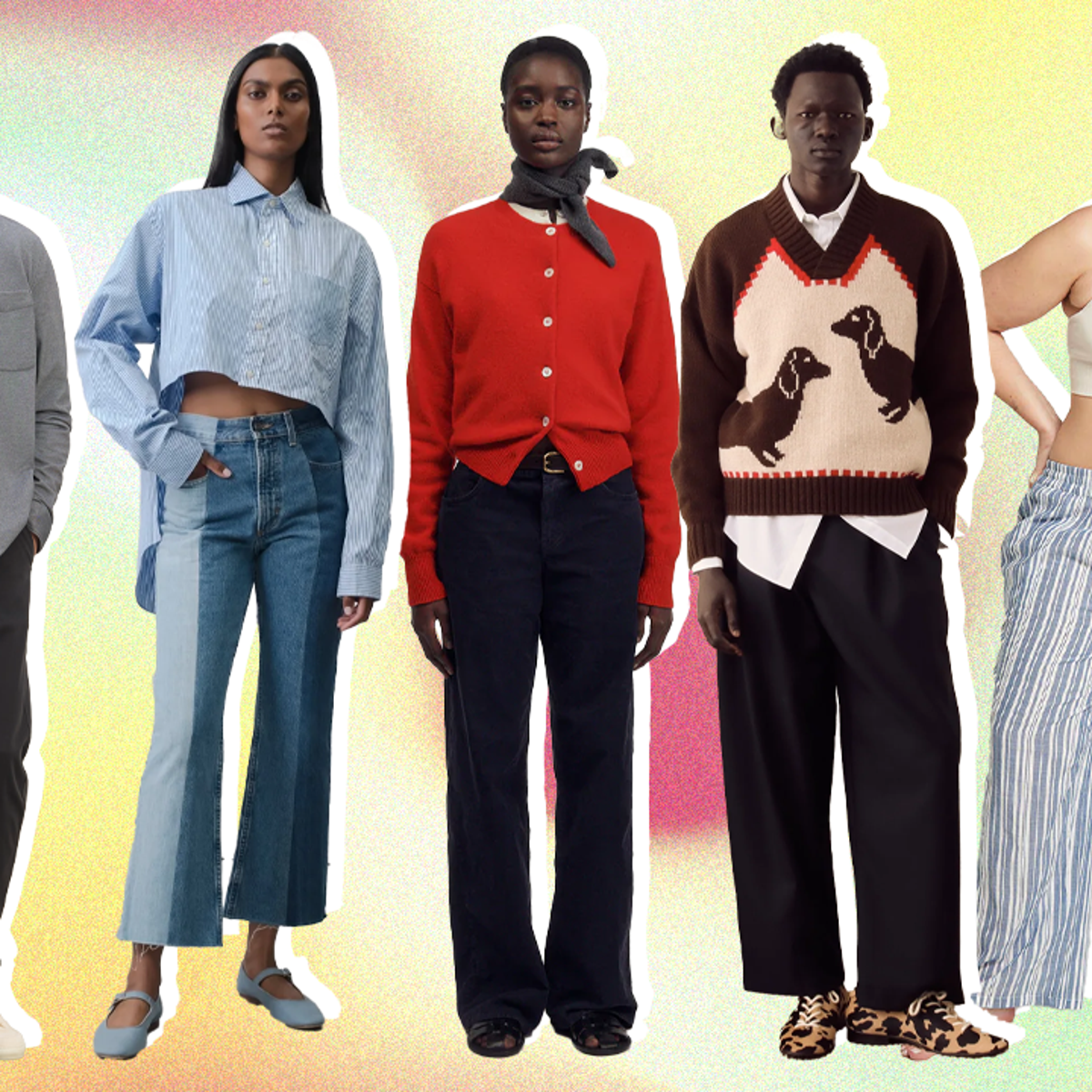How Branded Clothing Can Boost Confidence Through Fabric and Feel
How Branded Clothing Can Boost Confidence Through Fabric and Feel
Blog Article
Comprehending Clothing: The Value of Material Options in Your Closet
The choice of textile in clothing plays a pivotal function in both visual appeals and performance. Various products supply differing levels of toughness, comfort, and breathability, straight affecting the wearer's experience. Comprehending these subtleties can improve one's closet considerably. Yet, several neglect how these selections can affect not just personal design, however also sustainability. What textile choices could redefine your wardrobe and straighten it with both style and obligation?
The Function of Material in Style and Capability

Usual Textile Kinds and Their Features
When choosing clothing, recognizing the features of usual textile types is vital for making educated choices. Cotton, a widely-used all-natural fiber, is understood for its flexibility, breathability, and softness, making it ideal for sportswear and day-to-day garments. Linen, an additional all-natural choice, flaunts excellent moisture-wicking residential properties and a distinct structure, perfect for cozy climates.Wool, frequently favored for its warmth and toughness, differs in fineness; merino woollen is soft versus the skin, while coarser kinds are made use of for outerwear. Synthetic fabrics like polyester and nylon use sturdiness and resistance to creases, making them preferred for activewear and traveling garments. Blends, which incorporate natural and synthetic fibers, can enhance functionality while preserving comfort. By identifying these fabric characteristics, people can choose clothing that straightens with their way of living and visual preferences.
Breathability and Comfort: Selecting the Right Fabrics for Different Climates
Selecting the ideal materials for different climates can greatly enhance convenience and general wearability. Breathable materials are necessary in hot environments, as they enable air blood circulation and wetness dissipation. Fabrics such as cotton, bed linen, and moisture-wicking synthetics efficiently attract sweat away from the body, maintaining the user cool and completely dry. Alternatively, in cooler climates, thicker fabrics like woollen or fleece offer insulation while keeping breathability, guaranteeing heat without overheating.Additionally, the option of material weight plays a vital function; lightweight textiles are more suitable for summertime, whereas larger options are suited for winter wear. Understanding the unique buildings of each fabric makes it possible for individuals to dress appropriately for differing weather problems. Eventually, picking breathable and comfortable textiles customized to specific environments can substantially improve everyday convenience and improve the general experience of putting on apparel.
Toughness and Treatment: Exactly How Textile Impacts Durability of Your Closet
Picking the ideal products can substantially influence the resilience and care demands of a wardrobe. Fabrics such as cotton and polyester are recognized for their strength and convenience of maintenance, making them optimal for daily wear. On the other hand, fragile products like silk and shoelace require even more cautious handling and specialized cleaning techniques, which can enhance the moment and effort required for care. Branded Clothing.Durability is likewise influenced by the textile's weave and coating; snugly woven materials tend to resist wear and tear far better than loosely woven alternatives. In addition, artificial blends typically supply improved sturdiness, integrating the ideal top qualities of several fibers.Understanding the care instructions for each textile is important, as incorrect cleaning or drying can lead to early wear. Eventually, selecting long lasting materials can lead to a longer-lasting wardrobe, minimizing the frequency of substitutes and adding to an extra lasting fashion choice
The Impact of Fabric on Fit and Shape

Lasting Textile Selections: Making Eco-Friendly Choices
The influence of fabric prolongs beyond fit and shape to encompass environmental elements, motivating a growing interest in sustainable material choices. Environment-friendly materials, such as natural cotton, hemp, and Tencel, are getting traction amongst consumers who prioritize sustainability in their wardrobes. These products are frequently created with fewer chemicals and water, decreasing their ecological footprint.Additionally, recycled textiles, made from post-consumer waste, use a cutting-edge service to the fabric sector's air pollution problem. Brands increasingly welcome transparency in their sourcing approaches, enabling customers to make educated choices about their purchases.Choosing lasting textiles not only sustains moral methods but also motivates the garment industry to adopt even more liable manufacturing techniques. As recognition of ecological concerns browse around these guys rises, people are prompted to review the long-lasting influence of their textile choices, promoting a movement towards a more lasting and eco mindful method to style.
Boosting Design: Exactly How Textile Can Change an Outfit
While many may concentrate on shade and cut when choosing an attire, the selection of fabric plays a vital role in elevating style and improving total appearance. Different products share unique state of minds and messages; as an example, silk exudes deluxe and class, while denim offers a laid-back, relaxed ambiance. The structure and drape of a material can substantially modify the shape, with structured materials providing a polished look and softer ones creating a more fluid, relaxed aesthetic.Moreover, the weight of the material influences wearability across seasons. Lightweight fabrics like linen and cotton are ideal for summer, while much heavier products such as wool and velvet provide warmth and beauty in cooler months. Recognizing material residential or commercial properties, such as breathability and stretch, also equips people to make educated options that improve comfort without endangering design. Eventually, the ideal fabric can change an attire from common to amazing, making it a crucial factor to consider in any type of wardrobe.
Frequently Asked Inquiries
Exactly how Do I Recognize the Material Web Content of My Garments?
To determine material web content, one can take a look at care labels, conduct burn tests for fiber identification, or get in touch with material swatches. These methods assist differentiate products, guaranteeing educated selections for clothes treatment and maintenance in daily wear.
Can Fabric Selection Affect My Mood or Self-confidence?
Material choice can significantly affect an individual's state of mind and confidence. Branded Clothing. Certain products might evoke sensations of comfort or style, while others can really feel limiting or uncomplimentary, eventually affecting self-perception and psychological health throughout the day
What Fabrics Are Finest for Sensitive Skin?
For individuals with sensitive skin, natural textiles like bed linen, bamboo, and cotton are typically recommended. These products are breathable, hypoallergenic, and much less most likely to create inflammation, making them suitable options for convenience and skin health and wellness.
Just how Do I Correctly Clean and Take Care Of Different Fabrics?
To effectively wash and care for different textiles, one must think about each material's details needs, including temperature level settings, cleaning agents, and drying out approaches, making look at this site sure long life and preserving the material's initial high qualities for suitable usage.
Exist Specific Fabrics for Athletic or Efficiency Wear?
Athletic or efficiency wear usually uses materials such as spandex, polyester, and nylon. These products are made for moisture-wicking, breathability, and versatility, enhancing motion and convenience during exercises while offering longevity and assistance. Conversely, in chillier climates, thicker textiles like wool or fleece give insulation while keeping breathability, guaranteeing heat without overheating.Additionally, the option of textile weight plays an important role; light-weight textiles are view it preferable for summertime, whereas much heavier choices are fit for winter wear. In contrast, fragile materials like silk and lace require even more careful handling and specialized cleansing methods, which can boost the time and initiative needed for care.Durability is additionally affected by the textile's weave and coating; firmly woven fabrics tend to withstand wear and tear far better than freely woven options. In comparison, inflexible materials can restrict motion but offer a timeless, polished look.Moreover, the thickness and texture of the textile can influence the visual understanding of body shape. The impact of fabric prolongs past fit and shape to include environmental aspects, prompting an expanding interest in sustainable material options. The appearance and drape of a material can significantly modify the shape, with organized fabrics supplying a polished appearance and softer ones creating a more fluid, relaxed aesthetic.Moreover, the weight of the material influences wearability throughout seasons.
Report this page